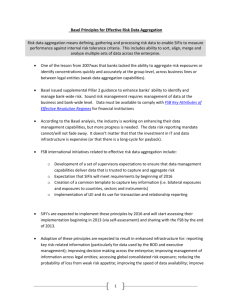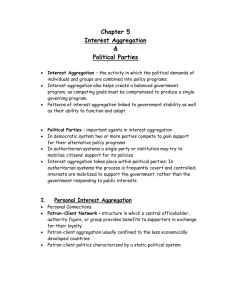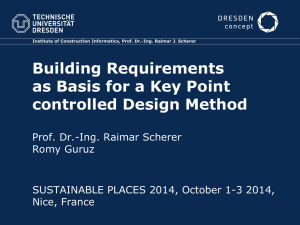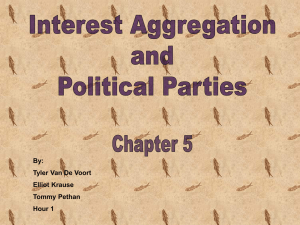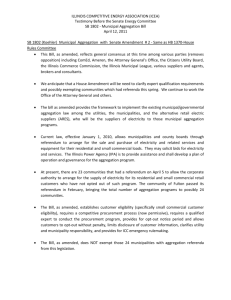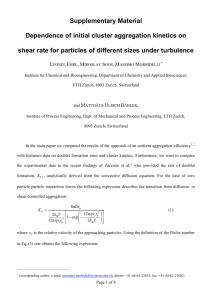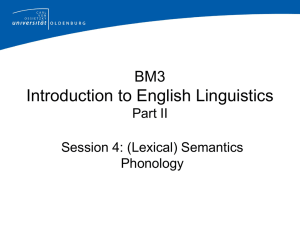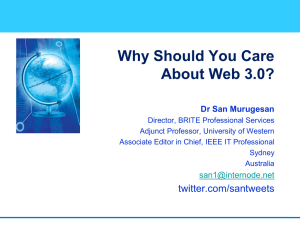5.Learning Cell
advertisement
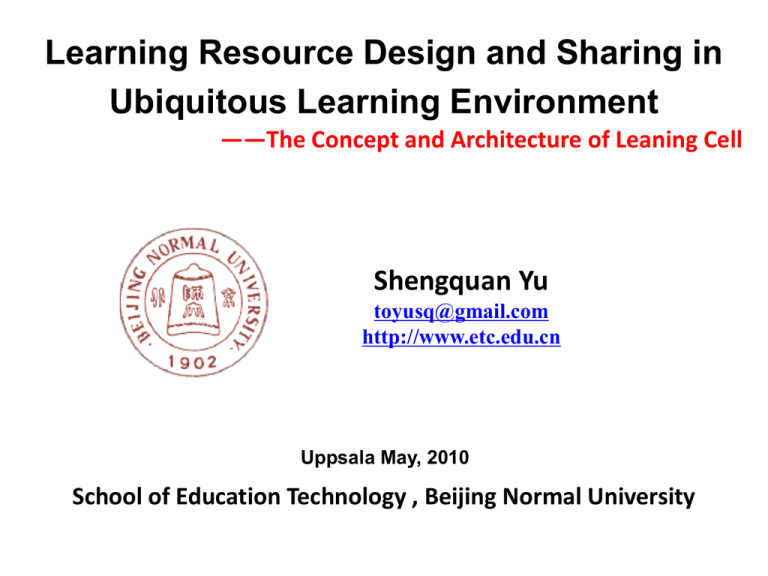
Learning Resource Design and Sharing in Ubiquitous Learning Environment ——The Concept and Architecture of Leaning Cell Shengquan Yu toyusq@gmail.com http://www.etc.edu.cn Uppsala May, 2010 School of Education Technology , Beijing Normal University Sorry, my English is poor, but I’ll try my best. 1.The Concept and Architecture of Leaning Cell Progresses of Learning Resource Sharing Technologies Reusable Learning Unit SCORM Learning objects IMS LD Learning activities Share of learning content Engineering methods and standards for learning content sharing share of education strategies and learning designs Future path? How to share generative information during learning process How to evolve learning content to adapt to all personalized demands? How to share social cognition network as well as resources? How to share interactive learning tools? How to implement content aggregation based semantic technology? How to relate learning processes? •More aggregation:form single resource to highly aggregated and complex resources •Extending sharing scope:from learning content to learning process and strategies •Technology upgrades:from static learning resources to learning tools & dynamic human wisdom sharing Ubiquitous Learning • On demand: Anytime, Anywhere, Mobile… But more: • Social • Situated • Context awareness • Adaptive Learning Resource Needed in Ubiquitous Learning • • • • • Anything about everything Adaptive: learning needs & all kinds of devices Collective intelligences Evolutive resources Situated Knowledge: help learner solve real similar problems Deficiencies of Current Learning Technologies(1) • On the background of Knowledge-explosion, the speed of knowledge updating is more and more faster • Current learning technologies only support single direction information delivery – – – – Experts provide content and solutions as information producers Learners are information consumers Ignores the valuable information generated during learning process Has a longer resource update cycle and a longer distance to users’ actual needs Deficiencies of Current Learning Technologies(2) • Lifelong learning and informal learning will be popular; ubiquitous learning also has a brighter prospect. Thus, there is large need for learning resources and designs that fits the learning on demand. • Current learning technologies emphasize formal learning, lacking of exploration and research for informal learning. – – – – How to design content for discrete user attentions How to share learning content on micro-granularity How to adapt display on all kinds of mobile devices …… Deficiencies of Current Learning Technologies(3) • Learning is not just to know knowledge itself, but to grasp learning methods, ways to get knowledge, and to build up a network where knowledge and human interact with each other • Current learning technologies emphasize learning resources and activities sharing in a close structure – Ignores the continuous updating of learning resources – Ignores dynamic and generative connection of learning resources – Ignores building up dynamic relationships between learners and teachers with learning resources This research try to proposal a new kind of learning source organizing model——Learn Cell The Concept of ”Learning Cell” • The meaning of “cell” – Component: learning cells can compose higher-level learning resources – Origin : learning cells grow from small to big, from weak to strong – Nerve cell: unite to get intelligence Component • Units that can reunite dynamically • standard Origin • Growing resources • Absorb collective intelligence & wisdom Nerve cell • Network according to semantic relation • Intelligence, communication ability “Learning Cell” • • • • • • • • • Generative Connectivity Micro-granularity Evolvable Cohesive Intelligent Social Open, communicates with other resources Adaptive to multiple end-devices and platforms Features of “Learning Cell”(1) • Learning cell is structural knowledge network – Interior:integrate content, activities and practices with extensible knowledge representation model – Exterior:different learning cells interact to build up a larger knowledge network Objective instruction Practice Learning content Assessment Learning activities Tool Base: BBS Interactive Q&A Online survey Online quiz Subject tool …… Aggregation Model • Different from tree structure of learning objects’ aggregation model, the aggregation model of “learning cell” is a dynamic network • From resource organization to knowledge organization; From linear tree-form structure to network structure course chapter paragraph Knowledge unit chapter chapter paragraph Knowledge unit paragraph Knowledge unit Hierarchy aggregation model Semantic network aggregation model Features of “Learning Cell”(2) • Runtime information communication through open services – “Learning cell” is open structured, and can communicate with other applications and share information – Resource sharing over organizations and systems 3 tell grab Service tool library 4 Information needed by learning cells 1 Learning cell service 5 put in (or link) Run Time Environment Learning Cell 2 get Features of “Learning Cell”(3) • The evolution of resources – Elements of learning cells include current version information, editing process description(e.g.: notes or revisions) and past versions. – The evolution and development is not aimlessly ,but in a structured and aggregated way, which is related to the interior knowledge structure model • The growth of resources – Save procedural information when learning resources are used. – E.g. discussion records in BBS, practice feedback, and evaluation results. the Growth of Knowledge 1 2 3 4 time 2009-03-12 2009-04-07 2009-04-28 2009-05-09 the Growth of Collective Intellgence • Describe users and editors in LCs, relate physical resources to human resources • Making LMSs share social network as well as physical resources through sharing LCs between cross-domain systems Learning Cell:from link information to link people .htm .jpg .htm .msg .jpg .htm .htm .htm .doc .htm Learning Cell:from link information to link people .msg .xls .htm .htm .jpg .jpg .htm .htm .doc .msg Features of “Learning Cell”(4) ——the Growth of Knowledge Using semantic technology to represent, inquiry and reasoning knowledge Gene of “learning cell” • Semantic model for disciplinary knowledge – Knowledge relation • • • • • • Upper-basic Part-whole predecessor-posterity foundation-development equivalence correlation – extensible – Reasoning foundation Co-editing, Learning activities, Communication service, Test & Assessment Activity records Editing records Metadata, aggregation model Knowledg e ontology assessmen t content practice Multiple format Service interface activit ies Sharable learning resources Generative information Usage records Learning cells stored in cloud-computing environment Learning community Generative information Assessment records Glacier Model of” learning cell” Logical Structure of “Learning Cell” Metadata, Aggregation Model Knowledge ontology Content Multiple format Assess ment Learning tool Learning community Learning content Practice Learning activities Learning assessment Service interface Learning records Semantic relation Activities Generative information Cloud-computing environment for Learning service Content Aggregation Model Net-Structured Aggregation Model • The formation of dynamic link – Creators of learning cells aggregate related learning cells into a larger knowledge network – Users of learning cells discover related learning cells or other learning resources during learning process, and put them in a personalized knowledge network – By setting subject keywords, similar learning cells and resources are searched automatically with the assistance of some semantic analysis functions to find new links – Analyze intelligently other learning cells that users have visited, to find out related element and form links – Users can find learning partners through links of learning cells to form social network links among users Comparison of “Reusable Learning Unit”, “Learning Object”, “Learning Activity” and “Learning Cell” Standardized Design Reusable No Learning cell Learning Yes object Learning activity Yes Learning cell Yes Share Scope Evolution Resource Producers Instruction material No Experts Structured learning content Reconstruction allowed Experts, teachers participate little Content and correspondent education design, methods and process Integrated learning information, not just current content, but also past version content and the knowledgeconstruction processes; not just content delivery, but also activities, tools, practices and assessments; not just preset information, but also procedural information generated during learning process and social network; not just learning content but also learning cognitive wisdom Reconstruction allowed teachers participate in more production Content and structure can evolve dynamically All participants can be producers, including students 2. Running Time Environment for Learning Cell Architecture Aggregate to Course Create Content Storage Create Edit tools Back to Learning cell Learning Cell Repository Call Learning Environment Connecting Inquire & Learn Recording Learning Portfolio Learning Interactive Learning Tools n to 1 learning 2.Running time environment based cloudcomputing technology provides service according to user’s request: – The most suited content – Related content – Usage records of the learning content – Evaluation records of the learning content – Editing records of the learning content – Tools for the learning content services Learning service interface 3. Send back the learning cell and related information 1. Users choose a learning cell to start learning process 4.Though the Learning services interface, connect with: – Other learners who use the same learning content – Experts that edit the content – Join the activities for the learning content – Then absorb experience, build learning relation, form learning community, promote multiple evolution and development of learning cells Learning pattern – Learning by reading/ learning by listening/ learning by watching (接受中学) • 基于学习对象的学习模式 – Learning by doing/ acting (做中学) • 基于学习活动的学习模式 – 学习元 学习环境通过将内容与活动、资源的无 缝整合,实现了以上两种学习方式的融合,使 学习者可以在学习内容的过程中,自然而然的 进入与内容密切相关的学习活动,实现更好的 学习体验 Learning pattern – Learning by connecting(联系中学) • 通过知识的语义关联和可视化导航,在知识的相互联 系中整体把握知识结构,从多个角度审视和思考,加 深对知识的理解,并有利于激发灵感和促进创新 – Learning by re-organizing(重构中学) • 通过学习元 聚合工具,学习者可以自由的组合和管 理多个小的知识单元,建构自己的知识体系,促进知 识管理 – Learning Comparing(同题异解,在比较中学) Learning pattern – Learning by reflection(反思中学) • 学习者不仅能学习当前的内容,而且能看到一个知 识单元生长和建构的历史轨迹,在这一过程性的情 境中反思知识的内在逻辑; • 学习元 环境为学习者保留了详细的学习记录,并提 供练习和评价,促进学习者在学习过程中对自身学 习的反思 – Learning by communicating(交流中学) • 学习者不止是通过物化的学习对象获取知识,更能 够通过学习对象关联到的专家、学习者,构建与学 习内容密切相关的社会认知网络,在交流中充分吸 收他人的智慧 Learning pattern – Learning by teaching(教中学) • 学习者在交流、协同编辑的过程中,可能经常性的切换 “教”与“学”的角色。许多研究表明,在“教”的过 程中,往往能够深化施教者对所教授内容的记忆和理解 – Learning by creating(创造中学) • 学习元 学习者不仅是被动的接受知识,而且可以在综合 、重组、反思、交流的基础上,形成结构化的表达,主 动的贡献智慧,创建新的知识内容 • 学习元 学习环境为其提供了开放的创造氛围和便捷的工 具,并且通过知识本体和投票与审核结合的机制,保证 多人协同创造的内容生长方向,为学习与创新相结合提 供了较为理想的平台 Run-time Environment of “Learning Cell” Terminals “Learning cell” underlying environment Information transmission controller PC PDA Resource database Location resource information Request Detect inf. Receive inf. Analyze inf. Universal network Resource index Information Resource search dispatch Resource location Resource search materials Resource history Public terminal White board Active adaper Wireless Internet Network Responce Display adaper Device type Screen size Screen resolution Learning cell runs Grow API Learning Cell transmission Learning cell extraction Learning cells Divide API Trace API Learning cell storage User informatio n Smart phone Learning service interface ... Mobile TV ... Learning tools Learning Learning Learning Learning community content activity assessment Learning records Semantic relation Summary Learning cell…… Extends shareable learning resources in space dimension Extends shareable learning resources in time dimension Adopts semantic aggregation mode, integrating content provided by different learners according to certain knowledge structure, which is a more practical resource sharing and co-editing mode. Utilizing cloud-computing and SOA technologies, making the platform highly open and extensible; On one hand, learning cells that are deposited in distributed devices and systems can be shared; on the other hand, it supports plug-in tools, providing multiple content and functions. • Projects – CETV: “New Media Learning Supermarket” – Higher Education Press: ”Knowledge Community” Thanks for your comment! Website: http://www.etc.edu.cn
